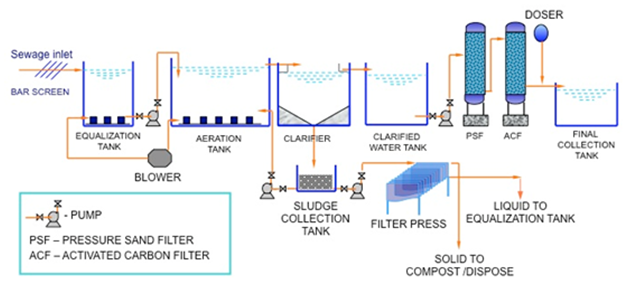Extended Aeration
The Extended Aeration Process, a modification of the Activated Sludge Process, effectively treats the contaminants in wastewater. It is a complete mix system and provides biological treatment for the removal of biodegradable organic wastes under aerobic conditions. The standard basis of design includes an aeration system, providing a 24-hour detention time and a final settling tank, with an effective 4-hour detention time. Diffused air is introduced into the aeration tank, this provides the proper environment for the development of aerobic bacteria. These bacteria thrive on the materials contained in the wastewater. The prolonged period of aeration, in addition, oxidizes a portion of the solids in the system.
Oxygenation by diffused aeration provides operating flexibility and standby reserve to meet the demanding requirements of varied package plant applications. Separation of the solids from the mixed liquor developed in the aeration tank takes place in the settling compartment. The clarified effluent is withdrawn for reuse or discharged into a receiving stream from the top of the settling tank. The settled solids are rapidly pumped from the bottom of the settling tank back to the aeration system. These Extended Aeration Plants are proven workhorses, providing excellent Biochemical Oxygen Demand (BOD) and Total Suspended Solids (TSS) removal efficiency.
Advantages Of Extended Aeration System
- Extended aeration processes are often better at handling organic loading and flow fluctuations, as there is a greater detention time for the nutrients to be assimilated by microbes
- Systems are odor free, can be installed in most locationsand can be landscaped to match the surrounding area
- Extended aeration systems have a relatively low sludge yield due to long sludge ages, can be designed to provide nitrification, and do not require a primary clarifier
Disadvantages Of Extended Aeration System
- Extended aeration plants do not achieve denitrification or phosphorus removal without additional unit processes
- Flexibility is limited to adapt to changing effluent requirements resulting from regulatory changes
- A longer aeration period and hence requires more energy
- Skilled personnel are required for the operation and control of return sludge and maintenance of MLSS concentration in the aeration tank

